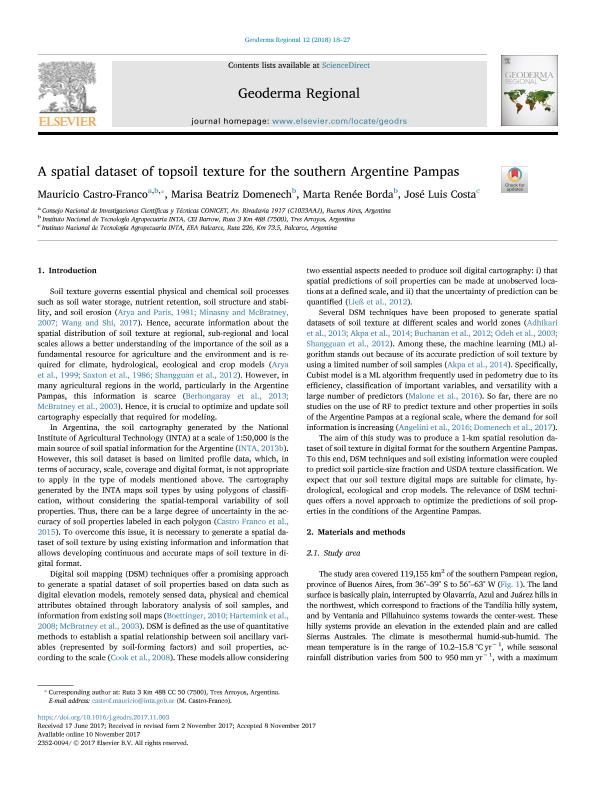Mostrar el registro sencillo del ítem
dc.contributor.author
Castro Franco, Mauricio

dc.contributor.author
Domenech, Marisa Beatriz
dc.contributor.author
Borda, Marta Renée
dc.contributor.author
Costa, Jose Luis

dc.date.available
2020-01-09T21:17:15Z
dc.date.issued
2018-03
dc.identifier.citation
Castro Franco, Mauricio; Domenech, Marisa Beatriz; Borda, Marta Renée; Costa, Jose Luis; A spatial dataset of topsoil texture for the southern Argentine Pampas; Elsevier; Geoderma Regional; 12; 3-2018; 18-27
dc.identifier.issn
2352-0094
dc.identifier.uri
http://hdl.handle.net/11336/94263
dc.description.abstract
Soil texture governs essential physical and chemical soil processessuch as soil water storage, nutrient retention, soil structure and stability,and soil erosion (Arya and Paris, 1981; Minasny and McBratney,2007; Wang and Shi, 2017). Hence, accurate information about thespatial distribution of soil texture at regional, sub-regional and localscales allows a better understanding of the importance of the soil as afundamental resource for agriculture and the environment and is requiredfor climate, hydrological, ecological and crop models (Aryaet al., 1999; Saxton et al., 1986; Shangguan et al., 2012). However, inmany agricultural regions in the world, particularly in the ArgentinePampas, this information is scarce (Berhongaray et al., 2013;McBratney et al., 2003). Hence, it is crucial to optimize and update soilcartography especially that required for modeling.In Argentina, the soil cartography generated by the NationalInstitute of Agricultural Technology (INTA) at a scale of 1:50,000 is themain source of soil spatial information for the Argentine (INTA, 2013b).However, this soil dataset is based on limited profile data, which, interms of accuracy, scale, coverage and digital format, is not appropriateto apply in the type of models mentioned above. The cartographygenerated by the INTA maps soil types by using polygons of classification,without considering the spatial-temporal variability of soilproperties. Thus, there can be a large degree of uncertainty in the accuracyof soil properties labeled in each polygon (Castro Franco et al.,2015). To overcome this issue, it is necessary to generate a spatial datasetof soil texture by using existing information and information thatallows developing continuous and accurate maps of soil texture in digitalformat.Digital soil mapping (DSM) techniques offer a promising approachto generate a spatial dataset of soil properties based on data such asdigital elevation models, remotely sensed data, physical and chemicalattributes obtained through laboratory analysis of soil samples, andinformation from existing soil maps (Boettinger, 2010; Hartemink et al.,2008; McBratney et al., 2003). DSM is defined as the use of quantitativemethods to establish a spatial relationship between soil ancillary variables(represented by soil-forming factors) and soil properties, accordingto the scale (Cook et al., 2008). These models allow consideringtwo essential aspects needed to produce soil digital cartography: i) thatspatial predictions of soil properties can be made at unobserved locationsat a defined scale, and ii) that the uncertainty of prediction can bequantified (Ließ et al., 2012).Several DSM techniques have been proposed to generate spatialdatasets of soil texture at different scales and world zones (Adhikariet al., 2013; Akpa et al., 2014; Buchanan et al., 2012; Odeh et al., 2003;Shangguan et al., 2012). Among these, the machine learning (ML) algorithmstands out because of its accurate prediction of soil texture byusing a limited number of soil samples (Akpa et al., 2014). Specifically,Cubist model is a ML algorithm frequently used in pedometry due to itsefficiency, classification of important variables, and versatility with alarge number of predictors (Malone et al., 2016). So far, there are nostudies on the use of RF to predict texture and other properties in soilsof the Argentine Pampas at a regional scale, where the demand for soilinformation is increasing (Angelini et al., 2016; Domenech et al., 2017).The aim of this study was to produce a 1-km spatial resolution datasetof soil texture in digital format for the southern Argentine Pampas.To this end, DSM techniques and soil existing information were coupledto predict soil particle-size fraction and USDA texture classification. Weexpect that our soil texture digital maps are suitable for climate, hydrological,ecological and crop models. The relevance of DSM techniquesoffers a novel approach to optimize the predictions of soil propertiesin the conditions of the Argentine Pampas.
dc.format
application/pdf
dc.language.iso
eng
dc.publisher
Elsevier

dc.rights
info:eu-repo/semantics/openAccess
dc.rights.uri
https://creativecommons.org/licenses/by-nc-sa/2.5/ar/
dc.subject
TEXTURE
dc.subject.classification
Ciencias del Suelo

dc.subject.classification
Agricultura, Silvicultura y Pesca

dc.subject.classification
CIENCIAS AGRÍCOLAS

dc.title
A spatial dataset of topsoil texture for the southern Argentine Pampas
dc.type
info:eu-repo/semantics/article
dc.type
info:ar-repo/semantics/artículo
dc.type
info:eu-repo/semantics/publishedVersion
dc.date.updated
2019-12-20T22:53:06Z
dc.journal.volume
12
dc.journal.pagination
18-27
dc.journal.pais
Países Bajos

dc.description.fil
Fil: Castro Franco, Mauricio. Instituto Nacional de Tecnología Agropecuaria. Centro Regional Buenos Aires; Argentina. Consejo Nacional de Investigaciones Científicas y Técnicas; Argentina
dc.description.fil
Fil: Domenech, Marisa Beatriz. Instituto Nacional de Tecnología Agropecuaria. Centro Regional Buenos Aires; Argentina
dc.description.fil
Fil: Borda, Marta Renée. Instituto Nacional de Tecnología Agropecuaria. Centro Regional Buenos Aires; Argentina
dc.description.fil
Fil: Costa, Jose Luis. Instituto Nacional de Tecnología Agropecuaria. Centro Regional Buenos Aires; Argentina
dc.journal.title
Geoderma Regional
dc.relation.alternativeid
info:eu-repo/semantics/altIdentifier/url/https://www.sciencedirect.com/science/article/pii/S2352009417301177
dc.relation.alternativeid
info:eu-repo/semantics/altIdentifier/doi/http://dx.doi.org/10.1016/j.geodrs.2017.11.003
Archivos asociados
